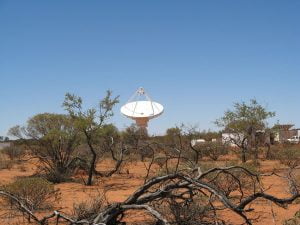
Image: The first ASKAP antenna, now erected in Western Australia. Credit: Dave DeBoer, CSIRO.
An historic milestone was reached recently in Australia’s bid to host the Square Kilometre Array telescope – a future international radio telescope that will be the world’s largest and most sensitive.
The first antenna to be assembled as part of the Australia Square Kilometre Array Pathfinder (ASKAP) telescope, an important precursor to the Square Kilometre Array, has received its first radio signals.
“ASKAP’s progress to date shows that our goals, although ambitious, are achievable,” said CSIRO’s SKA Director, Professor Brian Boyle.
”The journey to a thousand SKA dishes begins with a single photon.”
The first of 36 identical 12-metre dishes that will make up the ASKAP telescope, the antenna was assembled over the Australian summer at the Murchison Radio-astronomy Observatory in the Mid West region of Western Australia.
The first radio signals were received from a satellite and were part of a project to measure the shape of the antenna’s surface using holography.
This involves combining a satellite test signal reflected from the antenna’s surface with the same signal received by a small ‘reference’ dish, producing an image that shows if the antenna’s surface deviates from the ‘perfect’ shape.
“It’s a great moment – the first time a telescope receives light or radio waves – is always very satisfying and exciting. It means the project is firmly on track,” CSIRO ASKAP Project Director Dr David DeBoer said.
”The test results show that the antenna is working beautifully, beyond specifications.”
The first ASKAP antenna – 12m in diameter and 18m high – has an extremely innovative design, having three moving axes (altitude, azimuth and polarisation) whereby the entire dish rotates in unison with the sky. This unusual feature enables very sensitive images of the sky to be observed with the antenna’s phased array receiver or “radio camera”, making the processing of the signals much simpler than with conventional designs.
“We have arrived at this point thanks to tremendous efforts by the construction teams which erected the antenna through the heat of summer, and the team supporting the holographic testing,” Dr DeBoer said.
Construction of ASKAP’s next five antennas will proceed quickly with the first six antennas due to be operational by 2011 and the complete ASKAP system is expected to be completed by 2013.
Comprehensive site-acceptance testing of the antenna will be completed over the next few weeks. Additional CSIRO-made components, including feeds, receivers and data processing systems, will also be installed on the antenna’s structure.
Once built, ASKAP will be operated by CSIRO’s Astronomy and Space Science division which provides radio-astronomy facilities for use by Australian and international scientists.
ASKAP will allow astronomers to answer questions about cosmic magnetism, and the evolution and formation of galaxies, and to assist in the discovery of pulsars and possibly gravitational waves.

